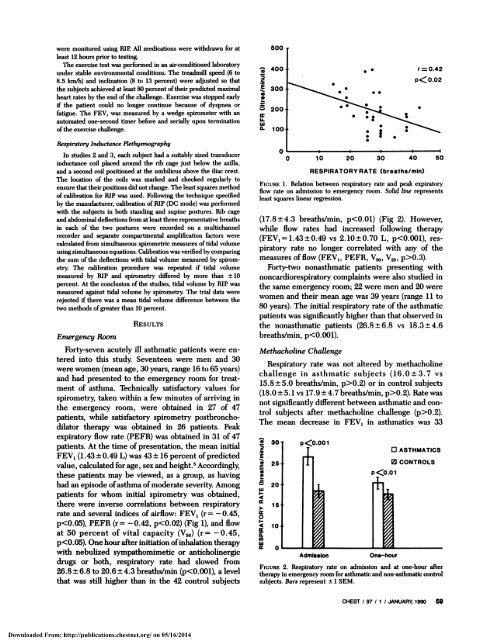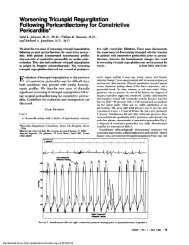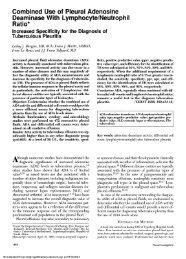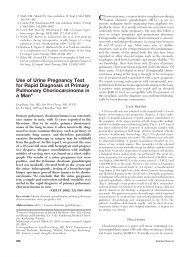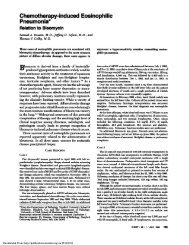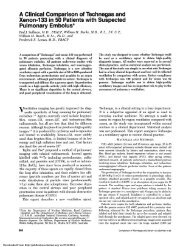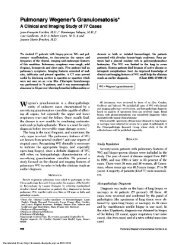Respiratory Rate during Acute Asthma*
Respiratory Rate during Acute Asthma*
Respiratory Rate during Acute Asthma*
You also want an ePaper? Increase the reach of your titles
YUMPU automatically turns print PDFs into web optimized ePapers that Google loves.
were monitored using RIP. All medications were withdrawn for at500least 12 hours prior to testing.The exercise test was performed in an air.condifioned laboratoryunder stable environmental conditions. The treadmill speed (6to8.5 km/h) and inclination (8 to 13 percent) were adjusted so thatthe subjects achieved at least 80 percent oftheir predicted maximalheart rates by the end ofthe challenge. Exercise was stopped early‘; 400C. 300SSS #{149} r0.42p< 0.02if the patient could no longer continue because of dyspnea orfatigue. The FEy, was measured by a wedge spirometer with anautomated one-second timer before and serially upon terminationofthe exercise challenge. 200U-w0.SRespiratonj Inductance PlethysmographyIn studies 2 and 3, each subject had a suitably sized transducerinductance coil placed around the rib cage just below the axilla,and a second coil positioned at the umbilicus above the iliac crest.The location of the coils was marked and checked regularly toensure that their positions did not change. Theleast squares methodof calibration for RIP was used. Following the technique specifiedby the manufacturer, calibration of RIP (DC mode) was performedwith the subjects in both standing and supine postures. Rib cageand abdominal deflections from at least three representative breathsin each of the two postures were recorded on a multichannelrecorder and separate compartmental amplification factors werecalculated from simultaneous spirometric measures of tidal volumeusingsimultaneous equations. Calibration was verified by comparingthe sum of the deflections with tidal volume measured by spirometry.The calibration procedure was repeated if tidal volumemeasured by RIP and spirometry differed by more than ± 10percent. At the conclusion of the studies, tidal volume by RIP wasmeasured against tidal volume by spirometry. The trial data wererejected if there was a mean tidal volume difference between thetwo methods ofgreater than 10 percent.EmergencyRoomRESULTSForty-seven acutely ill asthmatic patients were enteredinto this study. Seventeen were men and 30were women (mean age, 30 years, range 16 to 65 years)and had presented to the emergency room for treatmentof asthma. Technically satisfactory values forspirometry, taken within a few minutes of arriving inthe emergency room, were obtained in 27 of 47patients, while satisfactory spirometry postbronchodilatortherapy was obtained in 26 patients. Peakexpiratory flow rate (PEFR) was obtained in 31 of 47patients. At the time of presentation, the mean initialFEY1 (1.43 ± 0.49 L) was 43 ± 16 percent of predictedvalue, calculated for age, sex and height.5 Accordingly,these patients may be viewed, as a group, as havinghad an episode ofasthma ofmoderate severity. Amongpatients for whom initial spirometry was obtained,there were inverse correlations between respiratoryrate and several indices of airflow: FEY1 (r = - 0.45,p


